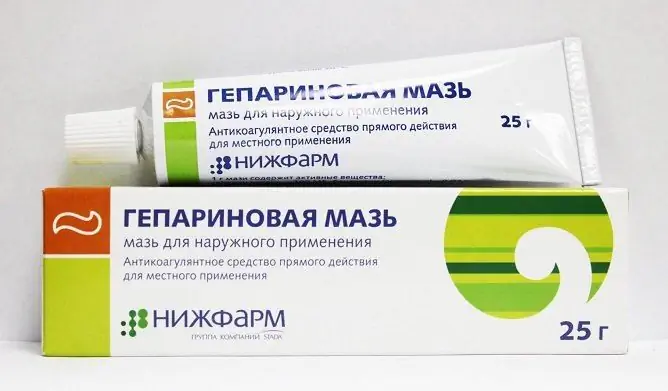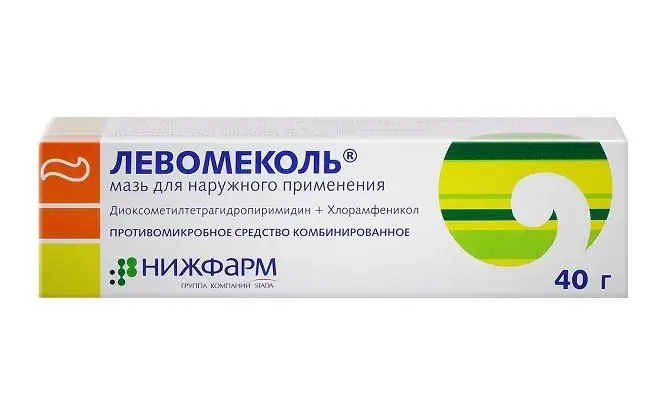- Author Rachel Wainwright [email protected].
- Public 2023-12-15 07:39.
- Last modified 2025-11-02 20:14.
Sinaf
Sinaf: instructions for use and reviews
- 1. Release form and composition
- 2. Pharmacological properties
- 3. Indications for use
- 4. Contraindications
- 5. Method of application and dosage
- 6. Side effects
- 7. Overdose
- 8. Special instructions
- 9. Application during pregnancy and lactation
- 10. Use in childhood
- 11. Drug interactions
- 12. Analogs
- 13. Terms and conditions of storage
- 14. Terms of dispensing from pharmacies
- 15. Reviews
- 16. Price in pharmacies
Latin name: Sinaf
ATX code: D07AC04
Active ingredient: fluocinolone acetonide (Fluocinolone Acetonide)
Manufacturer: JSC "Borisov Plant of Medical Products" (JSC "BZMP") (Republic of Belarus)
Description and photo update: 2019-09-07

Sinaf is an external drug with glucocorticoid, antiallergic, anti-inflammatory, antipruritic action.
Release form and composition
Dosage form - ointment for external use: homogeneous, from yellow to white (in aluminum tubes of 15 g, in a cardboard box 1 tube and instructions for use of Sinaf).
Composition of 1000 mg ointment:
- active substance: fluocinolone acetonide - 0.25 mg;
- auxiliary components: ceresin, propylene glycol, white soft paraffin, anhydrous lanolin.
Pharmacological properties
Pharmacodynamics
Sinaf is one of the external glucocorticosteroids. It has anti-inflammatory and anti-allergic effects.
Fluocinolone acetonide inhibits the release of inflammatory mediators. After application to the skin, the marginal accumulation of neutrophils is prevented, this leads to a decrease in the production of cytokines and inflammatory exudate, inhibition of the migration of macrophages, a decrease in the processes of granulation and infiltration.
Pharmacokinetics
When applied externally, fluocinolone acetonide has a low degree of systemic absorption and does not have a significant systemic effect on the body.
Indications for use
Sinaf is prescribed for short-term treatment of allergic and inflammatory skin diseases that occur with hyperkeratosis or persistent itching and react to local glucocorticosteroids.
It is preferable to use the drug for chronic processes and dry skin.
Contraindications
Absolute:
- trophic ulcers, which are associated with varicose veins;
- fungal, viral, bacterial diseases: pyoderma, blastomycosis, sporotrichosis, actinomycosis, herpes, chickenpox;
- perioral dermatitis;
- rosacea and acne;
- wounds in the areas of applications;
- cutaneous manifestations of syphilis;
- tumors and infections of the skin;
- diaper dermatitis;
- lupus;
- erosive and ulcerative lesions of the gastrointestinal tract;
- sarcoma, melanoma, skin cancer, atheroma, xanthoma, hemangioma, nevus;
- anogenital itching;
- pregnancy and lactation;
- age up to 2 years;
- individual intolerance to the components of the drug, as well as other glucocorticosteroids.
Sinaf ointment should not be used after vaccination.
The drug is not used in ophthalmic practice.
Sinaf, instructions for use: method and dosage
Sinaf ointment is applied only topically or topically.
A small amount of ointment is applied 1 to 2 times a day and rubbed lightly.
For children from 2 years of age, the drug should be used with caution under medical supervision once a day.
The duration of the course is determined by the nature of the disease and is usually 5-10 days, according to indications - up to 14 days.
It is necessary to avoid applying the ointment to large (from 20% of the body surface) lesions. The therapy can be carried out in combination with a non-drug ointment, it is applied 12 hours after Sinaf (provided that it is used once a day).
Sinaf can be used as part of a weekly treatment interval change with other non-drug ointments.
Ointment should not be used under an occlusive dressing, this method is possible only with psoriasis. In this case, the bandage must be changed daily.
Sinaf should not be applied to the skin for more than one day. The ointment should mainly be used in patients with dry forms of dermatoses.
Children are more sensitive to the drug than adults; when applied externally, the active substance can penetrate the body. Sinaf in children should be used in a course of no longer than 5 days in the lowest effective dose only on small areas of the skin (no more than 10% of the body surface area). It is unacceptable to apply the ointment on the child's face.
Side effects
- endocrine system: hyperglycemia; when applied to large areas of the skin - systemic manifestations in the form of adrenal insufficiency, Itsenko-Cushing's syndrome, steroid diabetes mellitus;
- digestive system: when applied to large areas of the skin - steroid stomach ulcer, gastritis;
- cardiovascular system: arterial hypertension, edema may develop;
- immune system: decreased body resistance; with prolonged use - slowing down of reparative processes, secondary immunodeficiency (in the form of exacerbation of chronic infectious diseases, generalization of the infectious process, development of opportunistic infections);
- skin and subcutaneous tissue: hyperkeratosis, furunculosis, perioral dermatitis, skin maceration at the application sites, atrophic streaks, urticaria, allergic contact dermatitis, maculopapular rash, skin irritation, violation of skin integrity; possible violations - secondary infectious skin lesions and atrophic changes in it (in the form of burning, itching, dry skin, steroid acne, folliculitis); with prolonged use - purpura, hypertrichosis, local hirsutism, skin atrophy, telangiectasia, pigmentation disorders, alopecia, especially in women.
Overdose
- main symptoms: burning and itching of the skin at the site of application of Sinaf, glucosuria, hyperglycemia, Itsenko-Cushing's syndrome;
- therapy: symptomatic with a gradual withdrawal of the drug.
special instructions
In cases where symptoms of irritation or skin allergic reactions (in the form of itching, burning or redness) develop against the background of the use of Sinaf, it is immediately canceled.
You cannot use the drug for more than two weeks without a break. The incidence of adverse reactions and the possibility of developing hyperglycemia, hypertension, edema, and a decrease in the body's resistance increases with prolonged use of the ointment on large areas of the body.
Sinaf should not be applied to the face. Contact with eyes must be avoided.
It is recommended to wear loose clothing during therapy. For the treatment of skin diseases that are accompanied by infection, Sinaf should be used in combination with antimicrobial drugs.
When using occlusive dressings, due to increased bioavailability, general resorptive effects characteristic of glucocorticosteroids may develop. With external use of Sinaf, it is possible to develop disorders in the form of a decrease in the production of adrenocorticotropic hormone by the pituitary gland, inhibition of the adrenal-pituitary gland system, a decrease in the level of cortisol in the blood and the development of iatrogenic Itsenko-Cushing syndrome. These pathologies are reversible (after drug withdrawal they disappear). With prolonged use, it is necessary to periodically monitor the function of the adrenal glands.
If an infection develops at the site of application of Sinaf, therapy should be discontinued and appropriate antifungal or antibacterial treatment should be carried out.
Avoid applying ointment to the skin around the eyes or eyelids in patients with open-angle and closed-angle glaucoma, as well as in patients with cataracts, given the likelihood of increased symptoms of the disease. Corticosteroids can be absorbed through the skin, therefore, use on large areas of the skin, long-term treatment, use under an occlusive dressing and in children should be avoided.
Children have a higher body surface to weight ratio than adults and are therefore at a higher risk of systemic glucocorticosteroid side effects, including Cushing's syndrome and hypothalamic-pituitary-adrenal axis dysfunction.
In the presence of atrophy of the subcutaneous tissue, mainly in elderly patients, the drug should be used with caution.
Avoid getting the ointment on the mucous membranes, in the eyes and on the wound surface.
Due to the risk of developing cataracts or glaucoma, the drug should not be used in the area around the eyes.
When treating patients with psoriasis, caution is required, since the use of Sinaf can lead to a relapse of the disease, which is associated with the development of resistance to the active substance. There is also the potential for generalized pustular psoriasis and systemic toxicity associated with cutaneous dysfunction.
It is possible to use Sinaf on the skin of the face, as well as on the skin of the armpits and groin, only if necessary, given the increased absorption of the drug and the high risk of adverse reactions, even with a short course.
Against the background of already existing conditions of atrophy of the subcutaneous tissue, therapy requires caution, especially in the elderly.
During the period of application of Sinaf, it is not recommended to vaccinate against smallpox, as well as to carry out other types of immunization (especially if the drug is used for a long time on large areas of the skin). This warning is due to the possible lack of an adequate immunological response (in the form of the production of the corresponding antibodies).
Lanolin is a part of Sinaf. The use of the drug can cause local skin reactions (including contact dermatitis). Also ointment contains propylene glycol, which can cause skin irritation.
You cannot use Sinaf on the skin of the mammary glands.
In case of ointments in the anal or genital region should consider that the white soft paraffin, part of the drug, reduces the strength of latex condoms and may lead to their rupture.
Application during pregnancy and lactation
Sinaf during pregnancy is not assigned.
There is no information on the penetration of fluocinolone acetonide into human breast milk, but it is known that other glucocorticoids are excreted in breast milk. A woman should refuse breastfeeding in case of prolonged use of the drug or treatment of large areas of the body. Infant contact with treated skin areas should be avoided.
Pediatric use
The safety profile of Sinaf in children under 2 years of age has not been studied, therefore its use in this age group of patients is contraindicated.
For children over 2 years old, the drug is prescribed with caution with the condition of applying to small areas of the skin.
Drug interactions
- non-steroidal anti-inflammatory drugs: the risk of local and systemic adverse reactions increases;
- potassium preparations, drugs with hypotensive, diuretic, antiarrhythmic action: their activity decreases;
- diuretic drugs (with the exception of potassium-sparing drugs): the likelihood of hypokalemia increases;
- drugs with an immunostimulating effect: their effect can be suppressed;
- drugs with immunosuppressive effects: their effect may be enhanced;
- systemic glucocorticosteroids: the effectiveness of fluocinolone acetonide increases, but at the same time, the likelihood of adverse reactions increases;
- medicines with antimicrobial action: Sinaf can be used in combination with these drugs.
Analogs
The analogues of Sinaf are Flucinar, Flucort, Sinaflan, Sinoderm, Esacinon, Sinaflan-Akrikhin, Sinalar, Fluocinolone acetonide, etc.
Terms and conditions of storage
Store at 5-15 ° C. Keep out of the reach of children.
The shelf life is 5 years.
Terms of dispensing from pharmacies
Dispensed by prescription.
Reviews about Sinaf
Reviews about Sinaf are few. It is indicated that the ointment has a quick therapeutic effect, however, in order to avoid the development of side effects, it is necessary to strictly adhere to the instructions.
Price for Sinaf in pharmacies
The price of Sinaf is unknown, since the drug is not available in pharmacies.
The approximate cost of analogs:
- Flucinar (0.025% ointment for external use, 1 tube of 15 g each) - 279 rubles;
- Sinaflan (0.025% ointment for external use, 1 tube of 15 g) - 70 rubles.

Maria Kulkes Medical journalist About the author
Education: First Moscow State Medical University named after I. M. Sechenov, specialty "General Medicine".
Information about the drug is generalized, provided for informational purposes only and does not replace the official instructions. Self-medication is hazardous to health!






